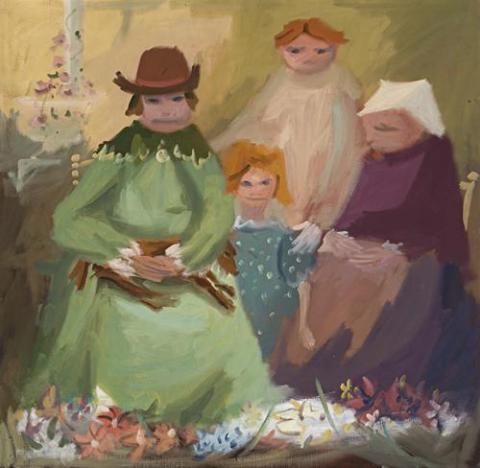THE RICH MINER'S FAMILY, 1960
Sam Fullbrook
oil on canvas
81.5 x 84.0 cm
signed lower left: Fullbrook
initialled lower right: SF
The Estate of Pro Hart, Broken Hill, New South Wales
Sam Fullbrook: Racing Colours, National Gallery of Victoria, 7 June – 24 July 1995, cat. 11 (label attached verso)
Moore, Felicity St. John, Sam Fullbrook: Racing Colours, National Gallery of Victoria, Melbourne, 1995, pp. 5, 10, 25 (illus.)
The Rich Miner's Family is a major work in Sam Fullbrook's oeuvre, being one of the sixty-three chosen for his prestigious retrospective exhibition at the National Gallery of Victoria in 1995. Aesthetically appealing in its superb colouring and light touch of the brush, it also shows Fullbrook's interest in the art of the past - in this case Australian, rather than his oft-quoted European touches of the Old Masters. Returning to Sydney from the Pilbara in 1960, Fullbrook became interested in the Holtermann Photography Collection in Sydney's Mitchell Library, The Rich Miner's Family being the first in a proposed series of paintings based on these photographs. Its source in the Holtermann Collection is Beaufoy Merlin's photograph of Louis and Mary Beyers and their two daughters on the back verandah of their house at Hill End, in about 1872. Beyers and Bernhardt Holtermann, who sponsored Merlin's photography, were partners with others in the Star of Hope gold mine at Hill End. The world's largest gold nugget, known as 'Holtermann's Nugget', was uncovered there in 1872.
Although inspired by a nineteenth-century photograph, The Rich Miner's Family is singularly a Fullbrook painting, of engaging wit and seductive colour. The composition is like that of the archetypal Victorian family photograph - grandma profiled in tones of purple, dominating figure of wife, with son and daughter all in fixed array. They look directly as they would at the photographer, who required absolute stillness to capture their likenesses on daguerreotype or by other similarly wondrous means. The tan and white dog on the wife's lap is probably a reference to Fullbrook's own terrier, Lucky, who made another appearance in a related painting, The Prospector, 1960, in a private London collection. The colours, which seem to float across the picture surface, are full of life, showing Fullbrook's characteristic interest in colour tones and their relationships. One of the particularly appealing features of Fullbrook's art is paradoxically its sophisticated naivety. Its seeming simplicity, however, comes from careful analysis and a fluent synthesis, painted with a directness furthered by his use of an alla prima technique. In this and many other paintings, dignity sits in harmony with the unconventional, giving his art that particularly idiosyncratic humour that so distinguishes it. Finally there are the flowers, a Fullbrook speciality, arrayed in colourful beauty at the feet of the sitters and as touches of delicate pink in a large urn to the left. Fullbrook once described civilisation as 'making things habitable for people, making it gentle.' He added, 'It's nice to be able to feel that you can achieve something with the gentle touch. Yeah 'delicate. Beauty.'1
1. Interview with John Cruthers, December 1985, from the film, Sam Fullbrook, Australia Council, quoted in the catalogue to the Fullbrook exhibition, Niagara Galleries, Melbourne, 1994, n.p.
DAVID THOMAS
